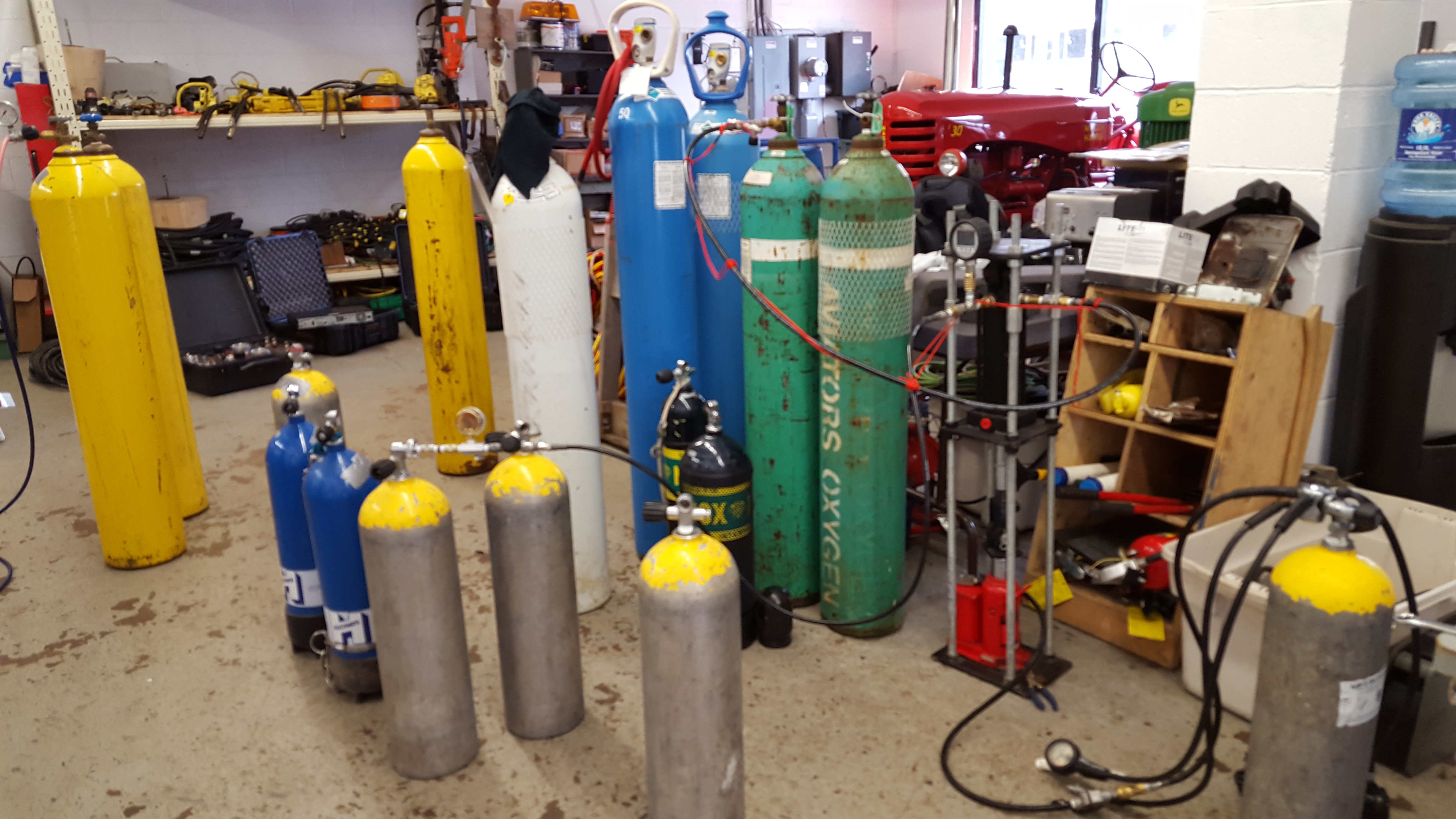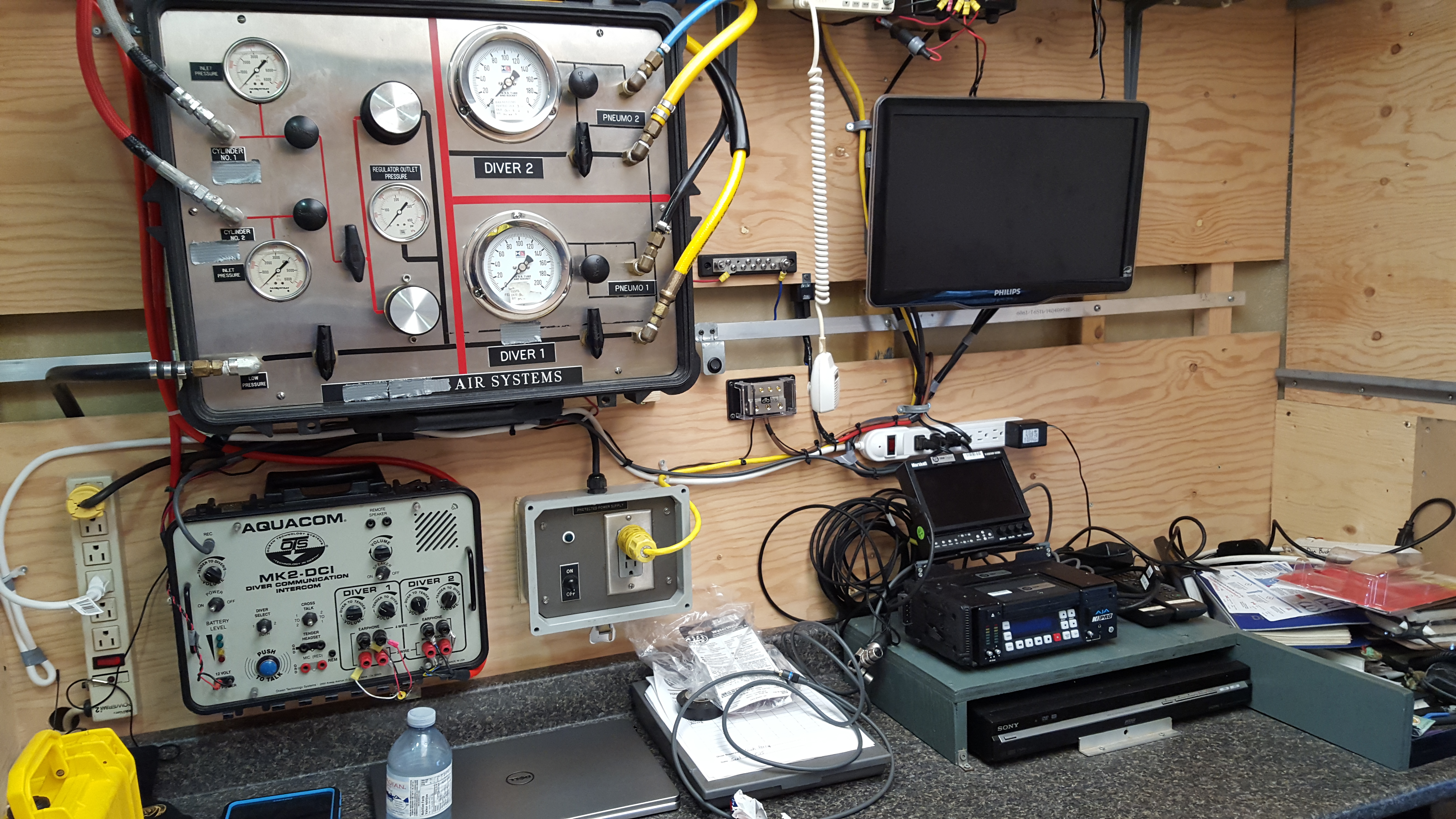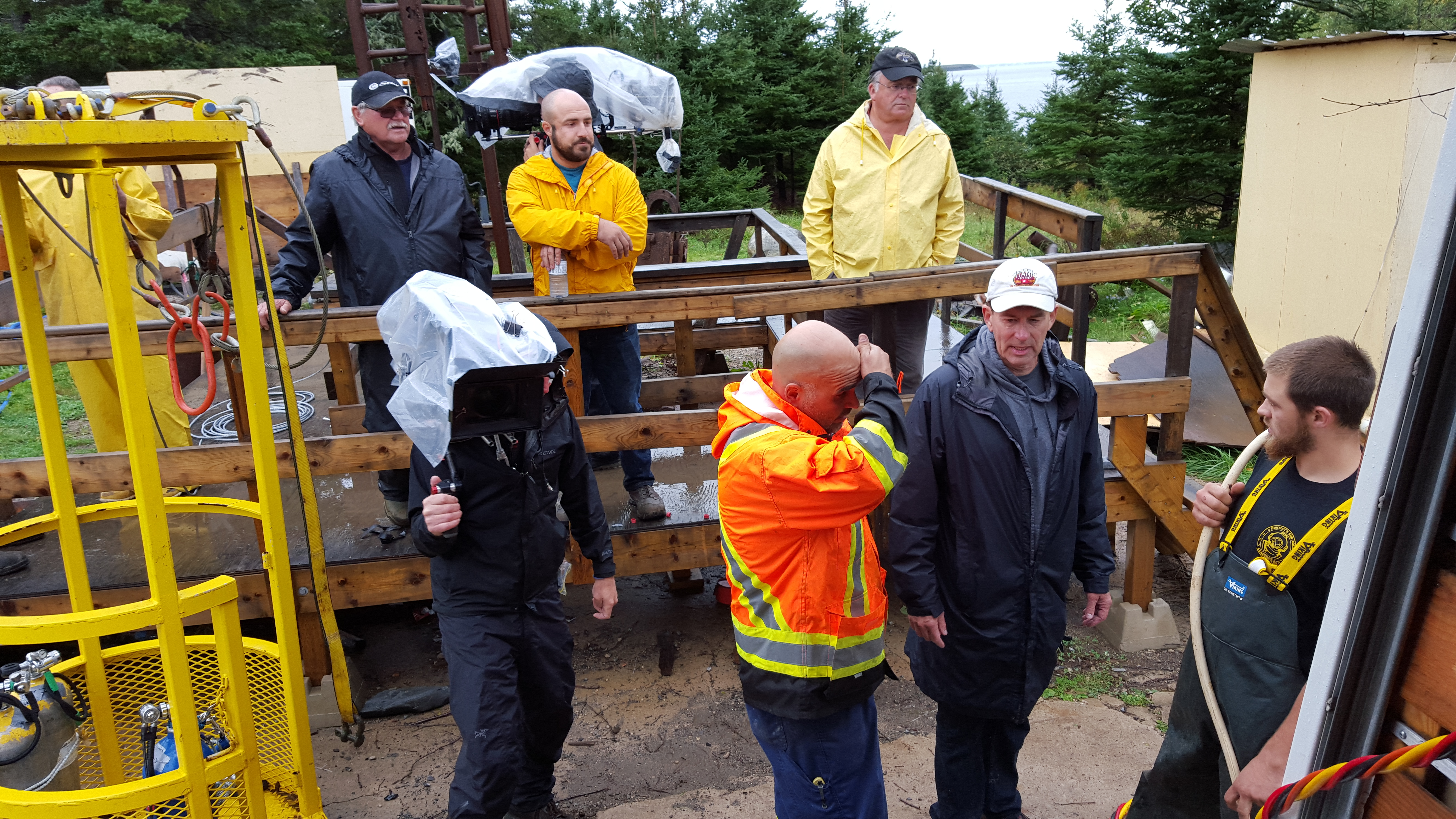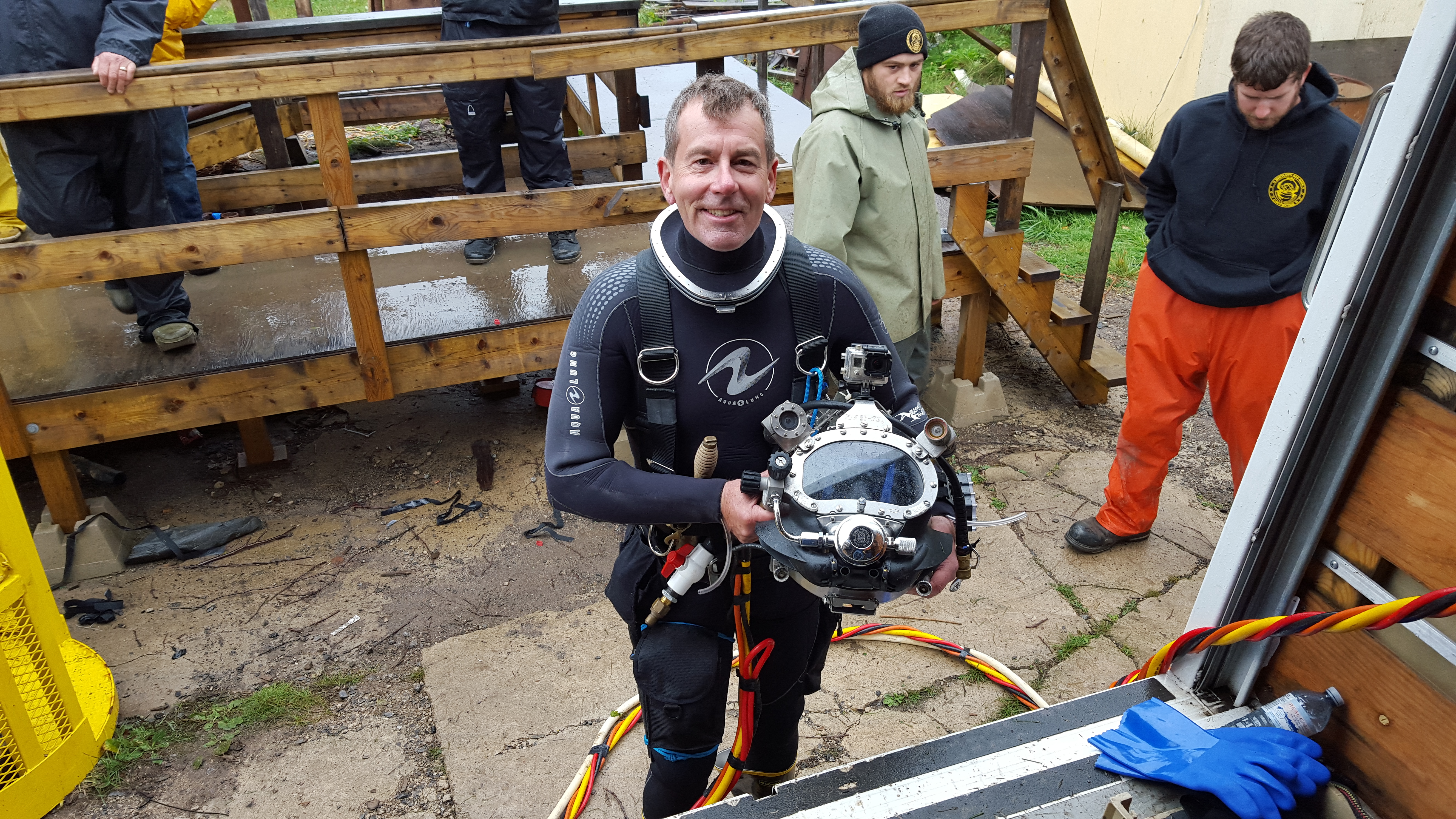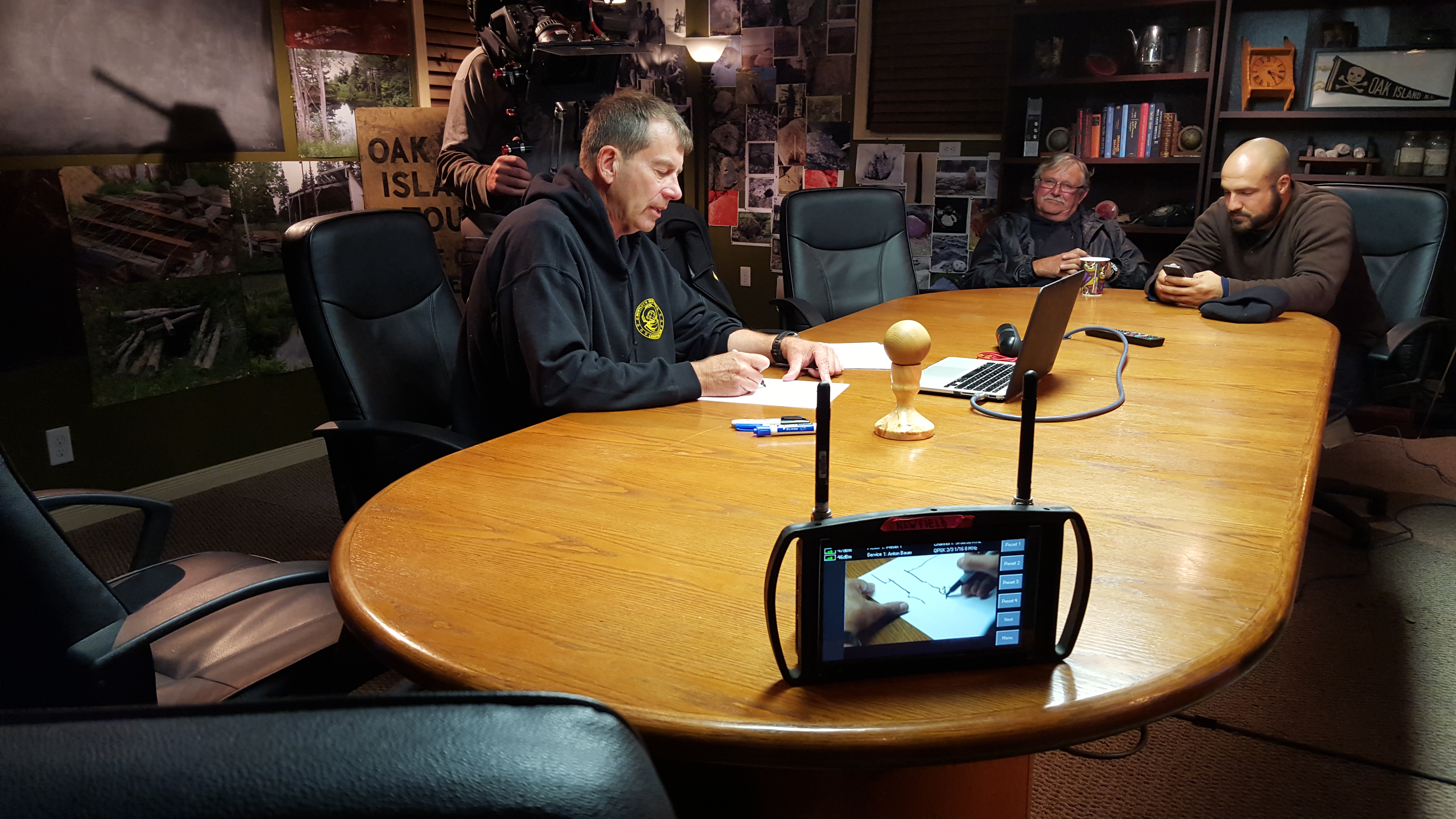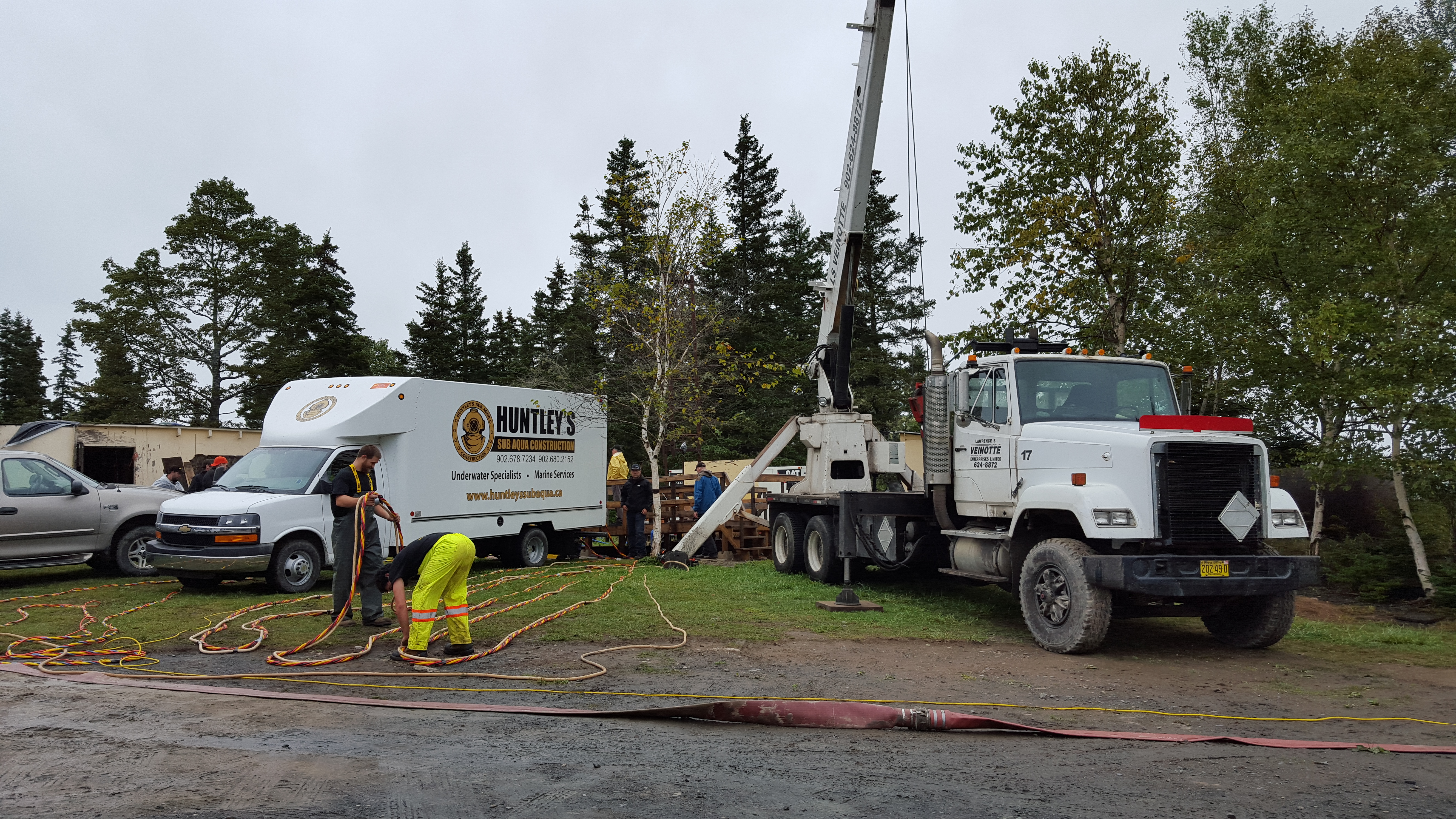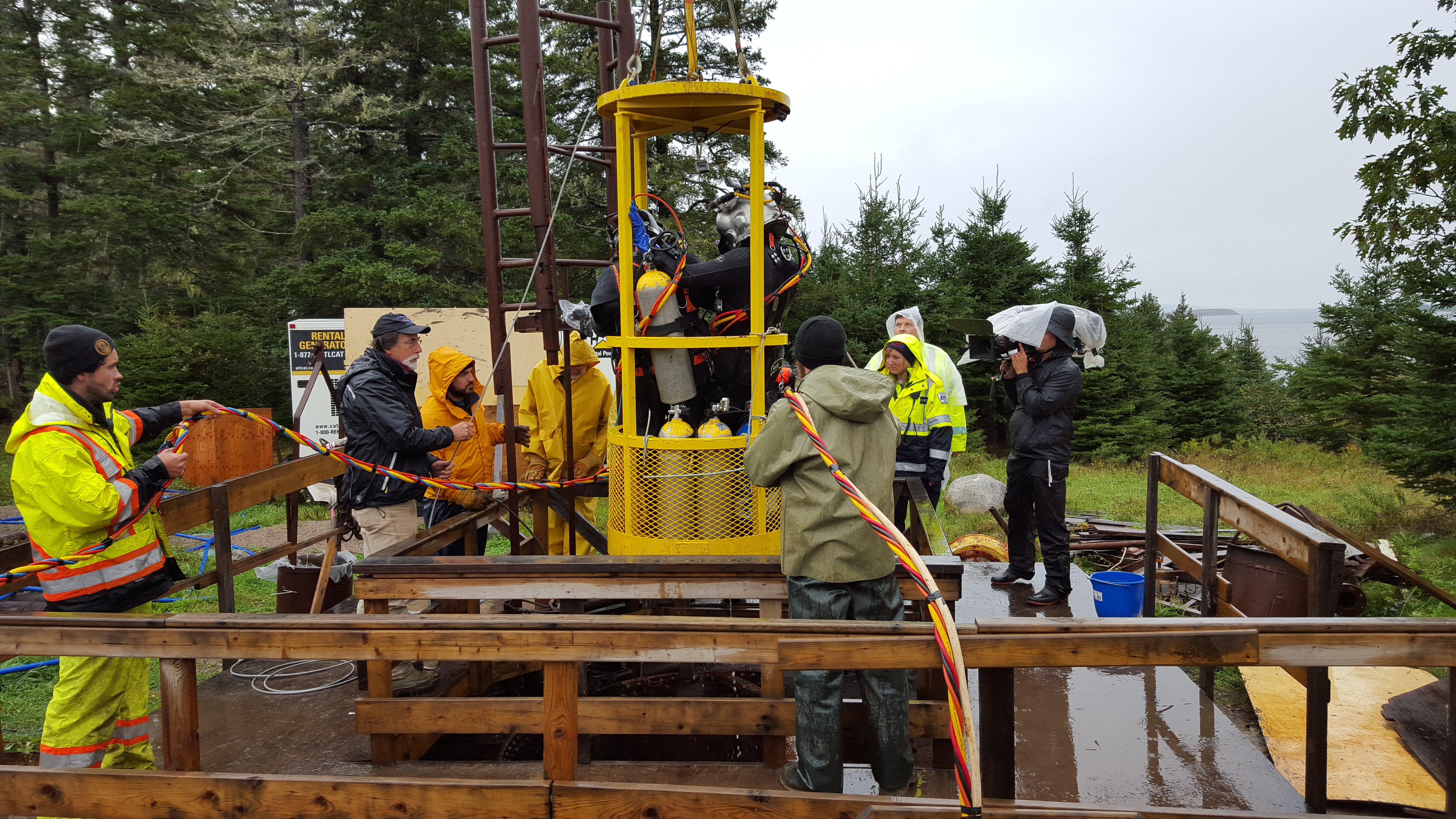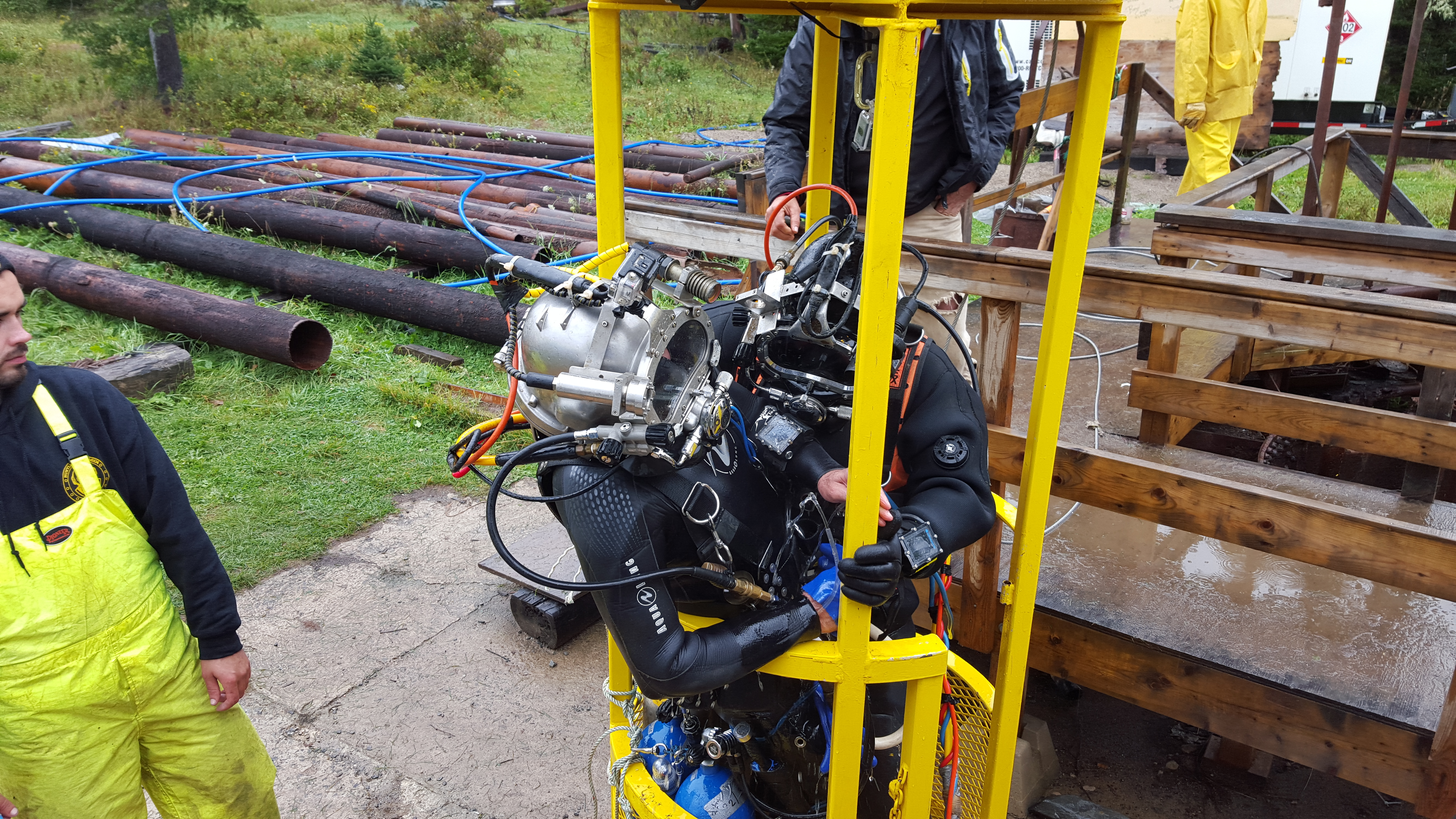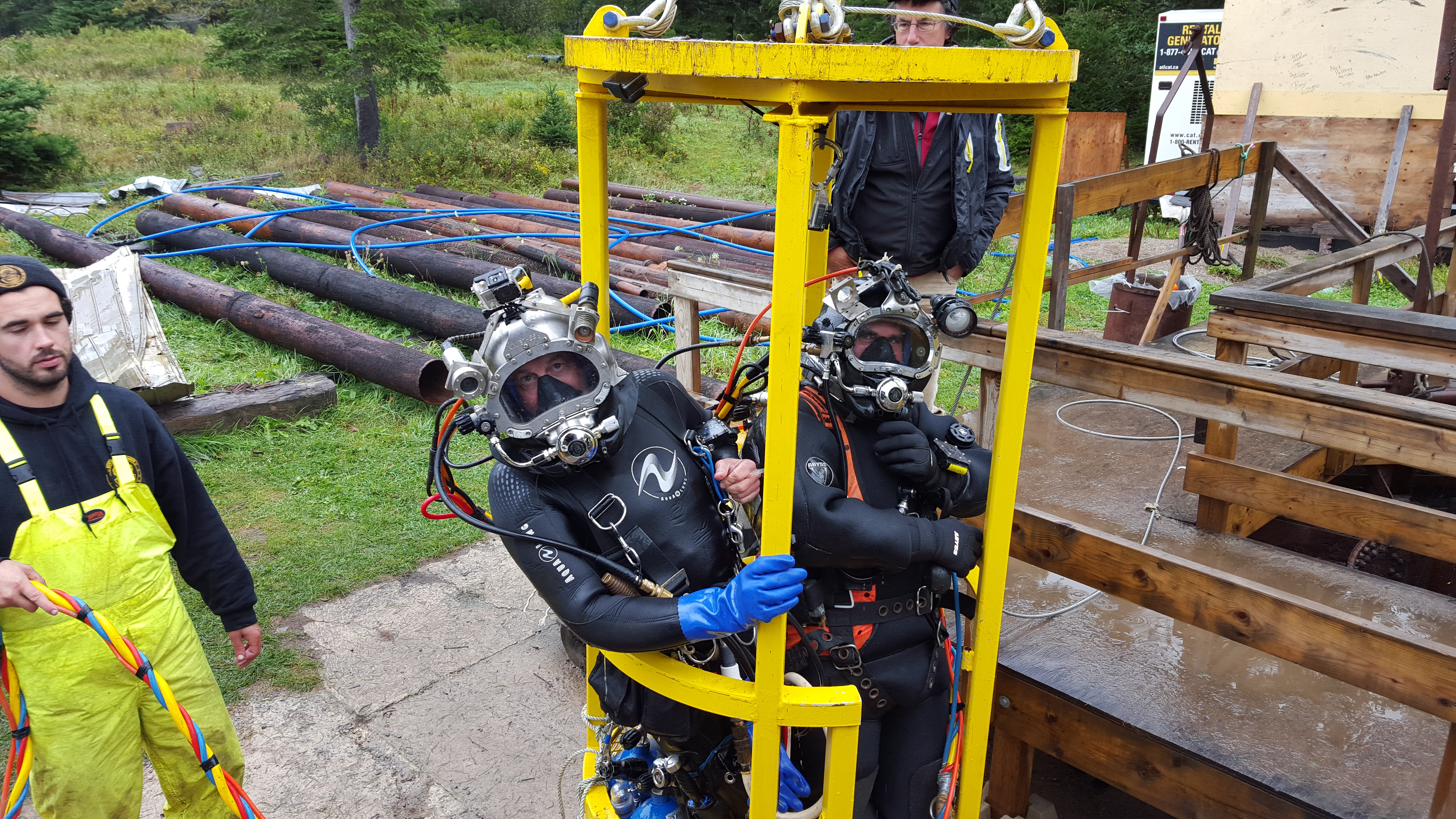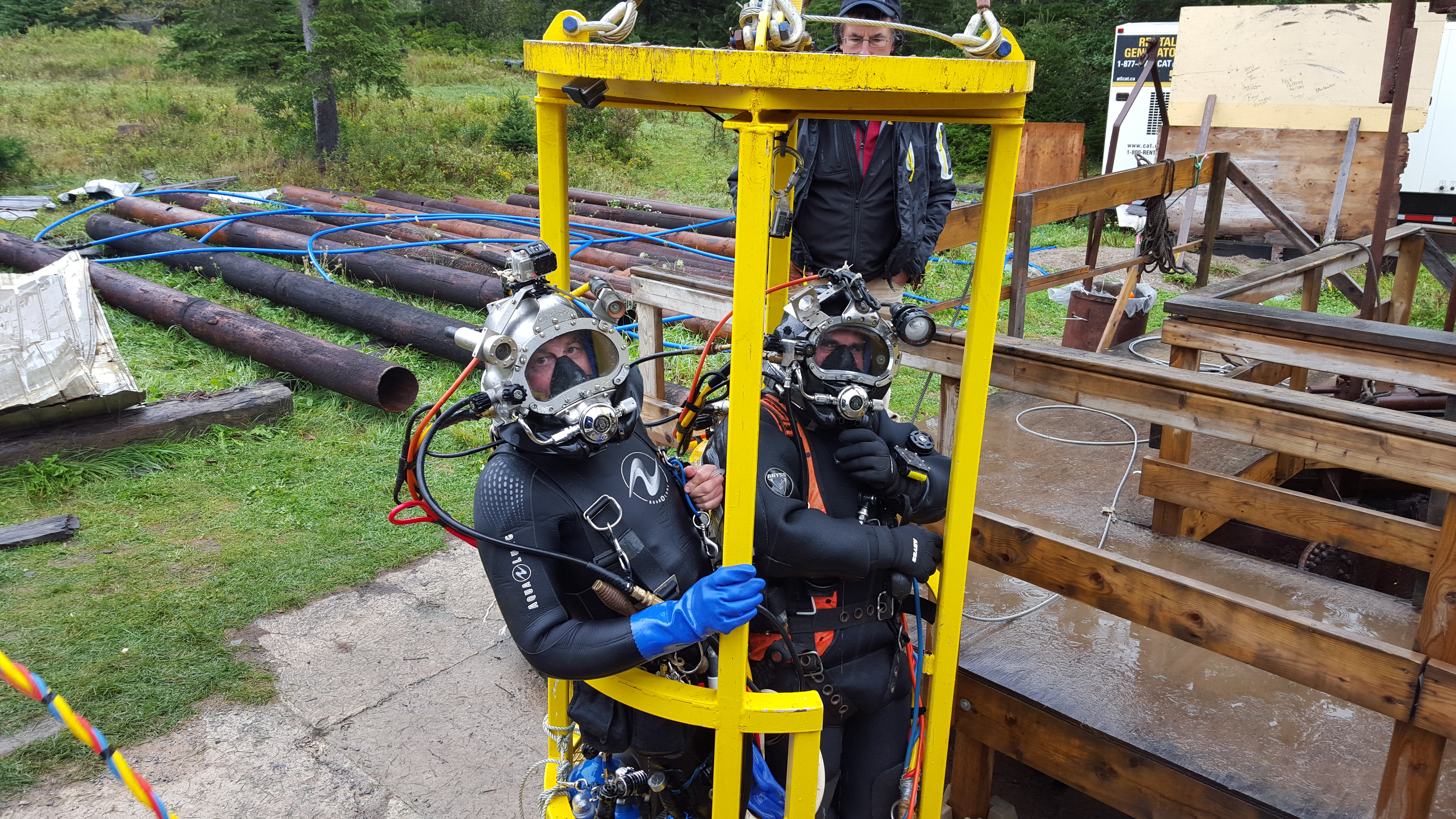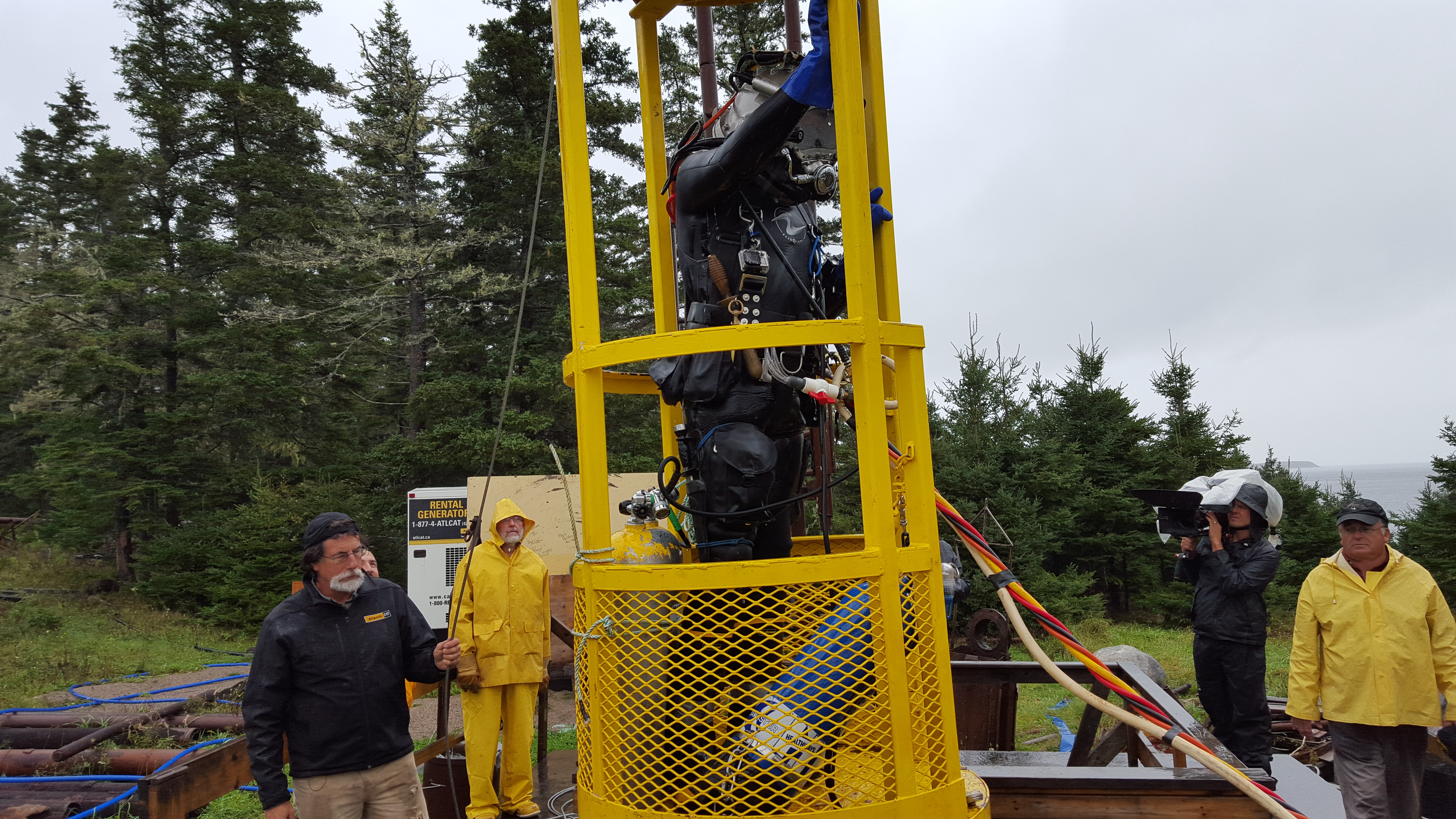Oak Island 10-X Dive
Howard Ehrenberg and myself were contacted about the possibility of conducting dives at a site known as the 10X Shaft, on Oak Island, Nova Scotia. After preliminary discussions, Howard and I were convinced we could do the dive, but the question was going to be how? Our first step in preparing for the dives would be to start developing our dive plan. Below is the dive plan we had in hand when we left for Nova Scotia.
The 10X site is a confined space dive, in roughly 200 feet of cold water, which would provide information to our clients, as well as be utilized for the popular television series Curse of Oak Island, on the History Channel. The episodes involving our dives aired in early February, 2016.
Oak Island Shaft Dive v 1.6
Introduction
The purpose of this document is to outline the Diving Operations for the 10X Shaft at Oak Island. The dates for the dive operations are TBD. All details of this dive plan, and any observations or conclusions made while preparing for, or executing the dives are entirely confidential.
Mission Statement
The goals for these dives are to obtain information on a Chamber estimated to be 10’ X 8’ X 10’, at the bottom of the 10X Shaft, in approximately 200 feet of water. As much as is possible, we will make a determination as to whether the Chamber is man-made, or geological, and whether or not there are any man-made artifacts in the chamber. We will conduct two days of diving to accomplish the mission to the best of our abilities.
Priorities
The first and foremost priority is the safety and welfare of the entire team. Every aspect of the diving operation is to be examined in the light of how it impacts crew and diver safety. No activity shall be undertaken which is determined to contain risks which cannot be managed within a reasonable degree of safety.
The second priority is to cause no damage to the site itself. No destructive testing will be conducted without prior approval and thorough analysis.
Known Conditions
Based on previous dives to the site, including limited ROV dives, we will operate under certain basic assumptions, all of which will need to be validated onsite. The purpose of these dives is to learn what is currently unknown. Therefore, all dives will be conducted utilizing constant evaluation and mitigation.
Current information as we understand it is as follows: There is a Main Shaft (caisson) which is roughly 7 foot in diameter, and rises approximately 45 feet above the water. This Main Shaft is steel, and descends to a depth of 185’ total length, with roughly 145 of the Main Shaft filled with water which is estimated to be 40⁰-48⁰ F. There is some expectation of debris in the Main Shaft, some of which be on the bottom, some of which may be mid water or overhead for divers on the bottom. This debris should be evaluated to determine if it needs to be relocated or removed, to prevent it from blocking egress, causing injury to the diver, or snagging the diver’s umbilical.
From the bottom of the Main Shaft, a 27-inch diameter Drill Shaft extends through bedrock vertically downward a distance of 45 feet until it breaks out into the Chamber. This places the bottom of Drill Shaft, which would be the uppermost part of the Chamber, at a depth of approximately 190’. This places the depth of water in the Chamber at approximately 200 feet of water. The Drill Shaft passes through bedrock with the walls of the shaft being solid rock. One prime consideration is loose rock in the Drill Shaft, which could come loose and entrap or wedge the diver.
At some time after the Drill Shaft was made, a second shaft was attempted adjacent to the first shaft. The cutting head of the drill apparently drifted into the 27-inch Drill Shaft, where at some point it seized up. The cutting head, and drill pipe were abandoned in place, and remain in situ. The drill pipe in the Drill Shaft has been described at entering the shaft as “halfway down”, which would make it about 20-25 feet down the Drill Shaft, or at a water depth of roughly 170 feet.
The degree of obstruction in the Drill Shaft from the cutting head is unknown, however we can assume that the 27-inch diameter of the Drill Shaft will be significantly restricted beyond the 27-inches.
The diameter of the drill pipe in the 27-inch Drill Shaft is unknown at this point, but can be assumed to be either 4-inch, or 6-inch. It is possible that the drill pile enters into the Drill Shaft only an inch or two, but it is equally likely the drill pipe bisects the 27-inch Drill Shaft. Should the drill pipe bisect the 27-inch Drill Shaft, it would leave us with a restriction at that point of less than 12 inches. We will plan for this restriction to be the crux of the dive, with the restriction of 12 inches at the drill pipe encroachment.
The Chamber is 10’ x 8’ x 10’ high, according to sonar surveying data. Visibility for both the Main Shaft and the Drill Shaft, has been shown to be extremely poor on the remote video, hence requiring manned presence and tactile skills to evaluate conditions.
Operational Outline
This plan covers two days of diving. The Chamber Diver will utilize surfaced supplied gear, with a demand helmet, hard wire communications, dive gas appropriate to the dive, and a hot water supply. In addition, video will be utilized with a system TBD. The “Chamber Diver” will work with a Support Diver to assist in tending the Chamber Diver’s umbilical as it makes the transition from the Main Shaft to the Drill Shaft. The equipment to be used by the Support Diver is TBD, however he will be in communication with the CD, and topside support.
All critical elements of the dive system will require backups. We will conduct two days of diving.
The first day of diving will consist of one or two dives as necessary. The dives will be conducted in the Main Shaft, to an estimated depth of 150’, and no greater than 170’. The goals for the first day of diving are as follows:
- Insure that all equipment is operational.
- Provide the crew the opportunity of familiarize themselves with the operation, and fine tune any issues not addressed in this plan.
- Identify any and all potential hazards not already known.
- Inspect the Main Shaft down to the Drill Shaft, looking for loose debris, and dive umbilical hangs.
- Clear any debris from the area around the mouth of the Drill Shaft, and remove and dive umbilical hangs.
- Inspect the Drill Shaft with regards to the degree of encroachment of the cutting head into Shaft.
- Install Down Line(s) as appropriate.
The second day of diving will consist of one or two dives as necessary. The dives will be conducted to a maximum depth of approximately 210’. The goals for this second day of diving are as follows:
- Penetrate down to the Chamber at the bottom of the Drill Shaft.
- Document the Chamber as much as time allows, utilizing video and tactile observations relayed to the Dive Supervisor over comms.
- Attempt to determine whether the Chamber is a natural formation, or man-made, and whether the Chamber contains any man-made artifacts.
Equipment
The following equipment will be utilized:
Rental Equipment
- Dive Gas supply cylinders for both Trimix, diver bailout, Deco Gas, and contingency gas supply.
- Bottom Gas cylinders with regulators and hoses to deliver gas to the KMACS 5
- Bailout Cylinders (2) for diver carry, with regulators and hose to deliver to KMSS37 dive hat.
- Deco Gas Stage Cylinders (6) for staging in the Diver Stage Basket, with regulators and hoses to connect to the KMSSS37 for decompression.
- Kirby Morgan Air Control System 5
- Hot water machine (make TBD)
- 300’ of dive umbilical with the following members:
- Dive gas hose
- Strength member if necessary
- Pneumo
- Hot water hose
- Comm Cable
- Video Cable (optional)
- Dive Stage Basket and Crane
Consumables
- Compressed gas
- Air – 600 CF
- Trimix 18/40 – 1400 CF
- Nitrox 70 – 600 CF
- Water source for Hot Water machine
Chamber Diver Gear
- KM37SS Helmet
- 7mm Wetsuit
- Weight Belt
- Shearwater Dive Computer
- Commercial Dive Harness with crotch strap D Ring, Shoulder D Ring, and Waist Strap D Ring for both side mounting and crotch mounting Bailout Cylinder
- Bail Out bottle (Minimum 72cf, steel preferred) with matching bottom Trimix gas, regulator, and gauge (TBD)
- Decompression Gas Cylinders (Minimum 72 CF, Aluminum 80 CF preferred)
- Personal gear including knives, boots, gloves, cable cutters
Support Diver Gear
TBD
Video
TBD
Dive Profiles
This dive plan provides for two days of diving, 4 dives total. The first day’s dives will be utilizing Air on the bottom, and Nitrox 70 for decompression. The second day’s diving will be utilizing Trimix on the bottom and Nitrox 70 for decompression, for the Chamber diver. The first day’s diving will be to prepare the site and to test the operation with regards to equipment and personnel. The second day’s diving will be focused on penetrating the Chamber and collecting information as directed.
Bühlmann GF ZHL – 16C
GF 30/70
SAC 1.2 cf/m Dive
SAC 1.0 cf/m Deco
Surface Interval between dives – 3 Hours
Dive #1
Dive: 150ft for 30 [ 30 ] on Air
Asc.: 120ft for 1 [ 31 ] on Air
Asc.: 90ft for 1 [ 32 ] on Air
Deco: 80ft for 1 [ 33 ] on Air
Deco: 70ft for 1 [ 34 ] on Air
Deco: 60ft for 3 [ 37 ] on Air
Deco: 50ft for 4 [ 41 ] on Air
Deco: 40ft for 4 [ 45 ] on EAN70
Deco: 30ft for 4 [ 49 ] on EAN70
Deco: 20ft for 8 [ 57 ] on EAN70
Deco: 10ft for 14 [ 71 ] on EAN70
Gas Consumption:
Air 239.7 cf
EAN70 47.6 cf
CNS 36%
Dive #2
Dive: 150ft for 30 [ 30 ] on Air
Asc.: 120ft for 1 [ 31 ] on Air
Asc.: 90ft for 1 [ 32 ] on Air
Deco: 80ft for 1 [ 33 ] on Air
Deco: 70ft for 1 [ 34 ] on Air
Deco: 60ft for 3 [ 37 ] on Air
Deco: 50ft for 4 [ 41 ] on Air
Deco: 40ft for 4 [ 45 ] on EAN70
Deco: 30ft for 4 [ 49 ] on EAN70
Deco: 20ft for 8 [ 57 ] on EAN70
Deco: 10ft for 16 [ 73 ] on EAN70
Gas Consumption:
Air 239.7 cuft
EAN70 50.2 cuft
CNS 43%
Here are some pictures that Howard took from his phone.
Dive: 210ft for 25 [ 25 ] on Tx 18/40
Asc.: 180ft for 1 [ 26 ] on Tx 18/40
Asc.: 150ft for 1 [ 27 ] on Tx 18/40
Asc.: 120ft for 1 [ 28 ] on Tx 18/40
Deco: 110ft for 1 [ 29 ] on Tx 18/40
Deco: 100ft for 2 [ 31 ] on Tx 18/40
Deco: 90ft for 2 [ 33 ] on Tx 18/40
Deco: 80ft for 3 [ 36 ] on Tx 18/40
Deco: 70ft for 4 [ 40 ] on Tx 18/40
Deco: 60ft for 6 [ 46 ] on Tx 18/40
Deco: 50ft for 14 [ 60 ] on Tx 18/40
Deco: 40ft for 6 [ 66 ] on EAN70
Deco: 30ft for 10 [ 76 ] on EAN70
Deco: 20ft for 15 [ 91 ] on EAN70
Deco: 10ft for 32 [ 123 ] on EAN70
Gas Consumption:
Tx 18% / 40% 354.5 cuft
EAN70 98.2 cuft
CNS 59%
Dive #4
Dive: 210ft for 25 [ 25 ] on Tx 18/40
Asc.: 180ft for 1 [ 26 ] on Tx 18/40
Asc.: 150ft for 1 [ 27 ] on Tx 18/40
Asc.: 120ft for 1 [ 28 ] on Tx 18/40
Deco: 110ft for 1 [ 29 ] on Tx 18/40
Deco: 100ft for 2 [ 31 ] on Tx 18/40
Deco: 90ft for 2 [ 33 ] on Tx 18/40
Deco: 80ft for 3 [ 36 ] on Tx 18/40
Deco: 70ft for 4 [ 40 ] on Tx 18/40
Deco: 60ft for 6 [ 46 ] on Tx 18/40
Deco: 50ft for 14 [ 60 ] on Tx 18/40
Deco: 40ft for 6 [ 66 ] on EAN70
Deco: 30ft for 10 [ 76 ] on EAN70
Deco: 20ft for 19 [ 95 ] on EAN70
Deco: 10ft for 51 [ 146 ] on EAN70
Gas Consumption:
Tx 18% / 40% 354.5 cuft
EAN70 129.3 cuft
CNS 81%
Risk Assessment and Preparedness Plan
Standard industry safety practices shall be utilized by all personnel, who are experienced and knowledgeable dive professionals. Any person, at any time, may bring safety concerns to the Dive Supervisor for appropriate action.
The purpose of this section is to identify specific potential underwater risks associated with our operational dive plan, and then determine both what we can do to prevent situations placing personnel at risk, as well as identify a plan to address hazardous situations that occur when our best efforts at prevention have failed. Awareness and preparation for potential risks are the best way to prevent diver injuries. With this knowledge, we will employ constant evaluation and mitigation.
The following Specified Risks are believed to be associated with this operation:
Emergency Surface Gas Supply
In addition to the calculated consumables, an additional supply of 3000 cf of air (in high pressure K bottles) will be on site, for use in any emergency.
Shaft Collapse or Diver Entrapment
There is virtually no risk of entrapment in the Main Shaft. However, it is entirely possible that the walls of the 27” Drill Shaft, or the Overhead in the chamber, contain loose rock. The presence of the diver, or the gas from the divers’ exhalation may cause cave in, collapse, or other dynamic situations which could entrap the diver, or his umbilical. There is virtually no cure for this situation, so the approach to this very serious issue is avoidance. The CD is solely responsible for making sure that identifies any loose rock in the shaft, or in the chamber overhead, and does not venture beyond the limits imposed by loose rock or debris.
Oxygen Toxicity
An OxTox event in the Drill Shaft or Chamber would be a serious situation. To minimize the risk of OxTox, we will utilize 18/40 Trimix, and analyze all gases 2X, virtually eliminating the possibility of OxTox during the bottom phase of the dive. The SD and the CD have extremely low CNS profiles, and the risk is minimal.
In the event of an OxTox event during decompression, the standby diver will coordinate the return of the CD to the surface, and vice versa.
Decompression Sickness
As with any deep planned decompression dive, there is risk of DCS. To minimize this risk, we will run parallel profiles, with the divers utilizing Shearwater dive computers, and the DS running real time profiles utilizing computer planning software of his choice. The most conservative profile will be the determining profile.
Umbilical Entanglement or Entrapment
Both divers will have to be vigilant with umbilical maintenance, which made more difficult by limited visibility. The CD will carry a set of cable cutters. In the unlikely event of the CD umbilical being entrapped where it cannot be freed, the CD will notify the DS and the SD, cut the umbilical with the cable cutters, go on bailout with no comms or SSG, ascend freely according to his decompression schedule, remain on BO gases and communicate to the surface through the SD, utilizing Helmet to Helmet contact communications.
Diver Injury or Illness
Every effort should be made to make sure both divers are fit to dive, prior to entry into the water. Should a diver become injured or ill while in the water, this will turne the dive.
Loss of SS Breathing Gas Emergency
Both divers will at all times be connected to Surface Supplied Gas, controlled by the DS, and to a Bail Out gas supply, controlled by the diver. BOG delivery will be tested and verified, with SSG shut off, prior to the divers descending below the surface for affirmative testing. Should a diver lose SSG, and need to switch to BOG, this will turn the dive.
Loss of How Water Supply
The loss of Hot Water Supply is a serious problem. To minimize the risk of system failure, there will be a single individual dedicated to the HWS, whose only job is to keep the HWS functioning properly. Any issues with the HWS will be immediately reported to the DS, and the dive terminated. Should the CD have to decompress without the benefit of HW, the dive profile will be expended as much as is practical, and the CD will surface and go on 100% oxygen for a time no less than 1 hour. As an additional safety, we will limit bottom times to 25 minutes duration.
Unexpected Event
In the event of any unexpected emergency situation, which is certainly possible when dealing with so many unknowns, the problem is to be identified, accurately commutated to all team members, properly evaluated, and responded to in a crisp and positive manner.
Team Assignments
Dive Supervisor
The Dive Supervisor (DS) will be the responsible person in charge topside. He will be responsible for supervising the Dive Station setup, and demobilization. During dive operations, he will remain in direct hardwire communications with both divers, remain in visual and verbal contact with the Dive Tenders (DT), and remain in verbal communication with the Hot Water Machine Operator (HWMO). In addition, he will coordinate the operation of the crane by the Crane Operator, as necessary.
The DS will be the liaison between the divers and the Project Supervisors, managing information requests between all parties.
The DS will manage the diver’s gas supplies, monitor dive times, coordinate the diver’s decompression schedules, monitor diver depths utilizing the Pneumo, coordinate any gas switches, and collect pertinent information provided by the divers regarding the goals of the dives.
Chamber Diver
Due to the unique nature of the dive, being the expected depths and difficulties in navigating the restriction around the Drill Pipe within the 27-inch Drill Shaft, the Chamber Diver will have to utilize a non-conventional dive equipment setup, while providing adequate backup for contingencies.
The CD will be the sole diver to enter the Chamber, and be solely responsible for addressing any hazards found in the Chamber. The CD will enter the water via the Diver Stage, lowered by the Crane to a depth of 40 feet of water. The CD will be responsible for notifying the DS when the Stage has reached that exact depth. The CD will communicate to the DS any findings from within the Chamber relating to the goals of the dives.
The CD will carry a conventional Bailout cylinder, but in a non-conventional way. The CD’s helmet will have a 3-foot hose connected to the helmet bailout valve, with a locking quick connect on the end. This quick connect will match another quick connect on a 3-foot hose to the bailout cylinder. When connected, this will provide bailout gas on a 6-foot-long hose, enabling the CD to carry the bailout cylinder clipped off to the CD crotch strap, with the bottle nestled between his legs. In this way, the bottle can be moved around to aid in navigation of restrictions by providing the diver with a minimal profile, while at the same time providing continuous bailout support. Once in the Chamber itself, the CD will have the option of side mounting the bailout cylinder, while moving about the Chamber.
Three cylinders of decompression gas will be secured to the inside of the Stage, and left at 40 feet during the bottom phase of the dive. Each deco gas cylinder will be equipped with the same sort of regulator and hose quick connect setup as the bailout cylinder. The deco cylinders will each contain identical gas, each with a SPG, and be properly marked.
This will enable the CD to disconnect the bailout cylinder, and connect to decompression gasses at will during decompression. The CD will be in constant communication with the DS regarding decompression, however the CD will be utilizing a Shearwater Predator Dive Computer, thus enabling him to access decompression data even in the event of comm failure with the surface. The DS will run a parallel decompression profile from the surface, coordinating times, depths, and gases, with the CD.
The DS will have the ability to provide decompression gas to the divers, however only in the event of a plan failure. The plan procedure will be for the CD to enter the Stage at 40 feet, disconnect the bailout, connect to the deco gas, have the DS shut down the SS gas supply to the helmet, make the deco gas live, verify the deco gas supply, notify the DS, and make the gas switch on the Shearwater. By putting the gas switch and decompression information in the hands of the CD, we are already prepared for comm failure. With active comms to the surface, all actions relating to decompression can be validated and vetted by the DS, utilizing the Pneumo and separate decompression profile.
As each stage of decompression is cleared by both the CD with the Shearwater, and the DS by separate means, the DS will coordinate the raising of the dive stage by the Crane operator to the next decompression depth. With the required decompression cleared, the CD will coordinate with the DS, and conduct additional safety decompression as is thought to be prudent.
Support Diver
The Support Diver (SD) will enter the water with the CD on the second day of diving only. The SD will share the Stage with the CD on entry, decompression stops, and exit from the water. The SD is not expected to, or equipped to dive into the 27-inch Drill Shaft, even in the case of emergency.
The SD will provide in water support to the CD, in order to accomplish the goals of the dives. Requests to help in management of the CD umbilical will be made by comms and conventional line pulls as necessary to the SD as well as the surface Diver Tender. The SD will remain in constant contact with both the DS and the CD, via hardwire comms. The SD will utilize a conventional surface supplied dive equipment setup, however he will also utilize a Shearwater dive computer, thus enabling independent decompression in the event of comm failure with the surface. As much as is possible, the SD will avoid extensive decompression.
The SD will enter the water with the CD in the Dive Stage, and trail behind the CD in order to manage both his own umbilical as well as the umbilical of the CD. The SD will exercise his own judgement in how to meet the responsibility of assisting in the management of the CD umbilical, while minimizing his exposure to depth. The SD will report depth changes to the DS in order for the DS to assist in managing the decompression profile for the SD.
The SD will dive on Air for both bottom gas and decompression gas, in order to simplify decompression, and keep him in close proximity to the CD.
Diver Tenders
The Dive Tenders (DT) will be responsible for the proper setup and breakdown of the dive station, as well as suiting up the divers and tending divers while in the water. While diving operations are underway, there will be one qualified DT for each umbilical in the water. During this time, the DT will remain on the diver’s umbilical, ready to follow commands from the DS as to adjustments of the umbilical.
Hot Water Machine Operator
The Hot Water Machine Operator (HWMO) will operate the machinery supplying hot water to the divers. Direction as to any changes in water flow, and temperature, will be given by the DS, and any issues preventing consistent hot water flow to the divers will be relayed immediately to the DS, who will in turn supply relevant information to the divers.
Crane Operator
The Crane Operator (CO)will follow directions from the DS or any person he specifically designates to provide signals to the CO. Only one person will provide hand signals to the CO. At all times, the CO will operate the crane slowly, as directed.
